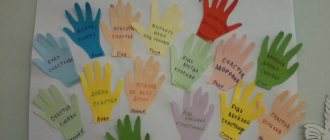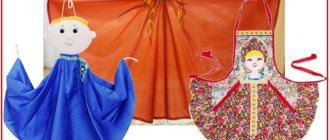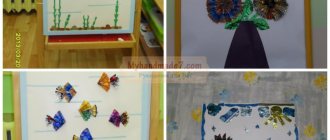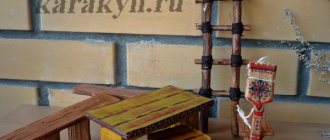Master class No. 2: painting plates using stencils and templates
Another method that anyone can master is painting dishes using stencils and templates.
To work you will need:
- Acrylic paints for glass and ceramics or felt-tip pens for painting dishes, which come in different colors and rod thicknesses. In Russia you can most often find markers from Marabu;
- Art synthetic brushes of suitable sizes (if necessary) or a sponge for tamping;
- Nail polish remover, alcohol or degreaser and cotton pads for degreasing;
- Everything you need to draw and cut out a stencil or template: paper, cutter, pencil.
Drawing technique
First, you need to draw or print a ready-made stencil/template yourself, and then use a utility knife to cut out the required holes. Perhaps, in this technique, only this stage can be called labor-intensive. Then everything is much simpler: degrease the surface and glue the template to the bottom with tape.
Then we paint over/stamp the design using the stencil. Then you can place accents on your picture, draw details or contours.
If you painted with acrylic paints, then you can dry them naturally, with a hair dryer or in the oven according to the recommendations of the first master class on dot painting of plates.
Pique technique
You can paint a plate with your own hands using the pique technique. In this case, the pattern will be created by applying dots along a given contour. This technique allows you to achieve the effect of beadwork, embossing or even inlay with stasis or precious stones.
For work, it is best to take durable contour acrylic paints. When choosing them, it is worth checking that they are the right consistency - not too liquid and not too thick. They should be easily squeezed out , but not spread into a puddle.
If the selected paints are not in tubes, but in jars, then you can apply the dots with a thin brush, toothpick or needle.
After carrying out the preparatory work (degreasing, priming), you can immediately begin applying the dot pattern. If such work is being done for the first time, it is better to first make a stencil, sketch or marking, and also think in advance about the color scheme of the future painting. It is very convenient to use a template that is attached to the back of the plate.
Decorative drawing
Decorative drawing is most accessible to students of a special (correctional) school of type VIII, so systematic training should begin with this type of activity. The content of this work is drawing up patterns in a stripe, square, circle, designing holiday cards, etc.
The source from which material for such lessons should be drawn is the diverse art of folk craftsmen, who reflect in their products the motifs of their native nature and national culture. Artistic wood and bone carvings, embroidery and lace, ceramics and glass, wood painting, toys and much more make up the wealth of folk arts and crafts. Acquaintance with its best examples to a certain extent shapes the aesthetic taste of students, promotes the gradual development of judgments about what is good and what is bad, and develops the ability to distinguish what is truly beautiful from bad taste and decoration. In addition, the demonstration of works by folk craftsmen helps to understand the peculiarities of constructing patterns and the advisability of their use in everyday life.
In decorative drawing classes, students learn technical techniques much more easily than in life drawing classes. This is facilitated by the relatively simple and therefore quite accessible to them visual basis of the ornament - repeatedly repeated plant motifs and a limited number of geometric shapes. The simplicity of the concept, combined with an elementary spatial composition, allows children to create decorative and ornamental drawings without unnecessary details. Using a small number of techniques, quite a lot of different patterns can be created, unique in color, composition and motifs.
Decorative drawing does not require absolutely precise knowledge of the object, which is necessary when drawing from life. When composing patterns, students operate with the simplest elements and shapes, select appropriate colors, follow the alternation of the same details or repeat them after a certain interval.
One more feature that should be noted that facilitates the process of working on a decorative design is the conditional choice of color. Since the student perceives the color in a drawing primarily as its decoration, he selects and compares colors according to the principle of “beauty.”
With appropriate pedagogical work, students of the eighth type school can develop a completely satisfactory perception of the color harmony that they are trying to convey in the drawing.
Decorative drawing is closely related to drawing from life and themes. Thus, drawing objects of symmetrical shape is preceded by drawing up patterns based on the principle of symmetry. Drawing patterns in a circle precedes and accompanies drawing round objects, etc.
Thus, decorative drawing is distinguished by the accessibility of the image, expressiveness more than other types of visual activity, and in many respects corresponds to the capabilities of mentally retarded schoolchildren.
To successfully complete the decorative painting curriculum, it is necessary to use a variety of teaching techniques and methods. Of great importance in this regard are methods that are aimed at developing children’s graphic, technical skills and, above all, correct actions with a pencil and brush.
In this case, the main attention should be focused on ensuring that students are able to correctly perceive the image (sample), think through the sequence of drawing, what and how to draw, imagine the final result of their work, etc. Therefore, when teaching mentally retarded schoolchildren how to use their hands correctly, it is necessary to direct their efforts to the development of various aspects of the personality of an anomalous child: to activate his perception, thinking, imagination, to the formation of feelings and the emotional-volitional sphere.
Let's consider methods aimed at developing students' ability to create an ornament and decorate one form or another with patterns.
First of all, it should be noted that the conversation that the teacher usually conducts with students immediately before starting a new work is of great importance when teaching decorative drawing. During the conversation, we introduce students to objects of decorative and applied art, inform them of the topic of the lesson, and talk about the content of the upcoming work. When showing a sample of a pattern (ornament), it is necessary to give students time so that they can carefully examine it. During the conversation, the aesthetic side of the pattern in question is emphasized, its structure is determined, and the main elements are highlighted. Children's attention is focused on the rhythmic alternation of the details of the drawing. When looking at a pattern, students identify its parts, compare and differentiate them by shape, color, and size. When analyzing a sample, children not only name decorative elements, note their location, but also indicate the number of these elements.
Preparing for the conversation, the teacher thinks through the content of the main questions. They should be concise in form, accurately formulated and understandable to children, and should also contribute to the activity of schoolchildren and encourage them to think.
In order to interest children in the upcoming work, to arouse in them a lively, emotional attitude to the drawing process, it is necessary to show, in addition to samples, the best drawings made by students in a parallel class, or similar exemplary works from the collection of children's drawings from the methodological fund of the school (class).
Explanation and demonstration occupy a particularly important place in decorative drawing lessons. The explanation should, as a rule, be brief and express the essence of the proposed task. Conciseness does not exclude a complete presentation of educational material. It is advisable not to use complex and long phrases. Otherwise, mentally retarded students may be indifferent to the explanation and will not understand the teacher’s instructions.
An effective method of explaining how to act when mastering a particular method of composing a pattern is a visual demonstration. The teacher’s drawing on the board (or on a large sheet of paper), which gradually appears before the students’ eyes, is the most effective means used in teaching decorative drawing.
In the lower grades, part of the task can be completed directly following the actions of the teacher, i.e., students draw as if under dictation. “As I draw on the board,” says the teacher, “so do you in your notebooks.” In high school, this method should be used less often. However, a complete demonstration and detailed explanation of the sequence of execution of the ornament should be used systematically.
Explanation and demonstration as teaching methods give good results if the teacher constantly activates students, stimulates them to mental activity, strives to increase their interest in classes and their ability to purposefully perceive what he explains and shows.
When teaching decorative drawing, samples prepared for the lesson are extremely important. They reflect the variety of decorative motifs and are an example of what patterns in a stripe, square, circle can be; The samples show how differently the patterns are arranged in the same geometric shape. By looking at them, students learn the concept of a beautiful combination of colors and more correctly convey the relative size of the pattern elements in a drawing; By following the examples, children more easily learn the technique of drawing with colored pencils or paints. The model is a criterion in the work, a standard to which students strive; A colorful drawing captivates and inspires a child, encourages him to be active, and promotes purposeful completion of a task.
In one lesson, it is advisable to show three or four samples that differ from each other in one particular feature, for example, the selection of elements or their arrangement. The teacher's task is to ensure that students are able to understand what is the same about them and what is different from each other. In this regard, special attention should be paid to a comprehensive analysis and study of the sample.
It should be recommended to draw up patterns on ready-made forms attached to a board or easel. For this purpose, you can prepare (cut out of colored paper or cardboard) the elements necessary for constructing the ornament (geometric - circles, squares, triangles, etc. or figurative - flowers, berries, leaves, etc.). One or two students properly place the components of the pattern in a geometric shape, and the rest monitor the completion of the task. Each student has similar figures (smaller in size). Therefore, after observing the work of their comrades, everyone makes an ornament on their desk.
This technique allows you to demonstrate to children various ways of composing an ornament and helps them understand its structure. During the preparatory work, students see that different patterns can be made from the same elements, that the ornament will only work if the component parts are repeated rhythmically or arranged symmetrically.
In the process of learning decorative drawing, children should be encouraged to explain themselves how to make a pattern in one form or another, and where to place the details of the drawing. For students, such work presents a certain difficulty, as it requires them to demonstrate independence. Children especially find it difficult to select decorative elements. During the initial period of training, they need to provide some assistance (in particular, it is advisable to hang a table with images of leaves, flowers, branches, berries, butterflies, beetles, etc.). Looking at the table, children select the objects needed for the pattern, simplify their shape and structure, and select the color. In the first lessons, when students are given the task of creating an ornament on their own, you can use a table with images of ready-made – stylized – elements. It must be especially emphasized that the desire of students to come up with “their own” pattern should always be encouraged.
In an effort to develop the activity of schoolchildren, it is useful to devote some part of the lesson to the collective invention of ideas. To do this, students take turns going to the board and sequentially decorating the appropriate form.
It is possible to teach children decorative drawing only by observing a certain sequence in the presentation of educational material. ethically based tasks, naturally arising from the peculiarities of drawing and the specific development of visual activity of students in a auxiliary school, can be represented by the following system: drawing ornaments from ready-made samples; drawing ornaments according to a given pattern; drawing ornaments from these elements; independent drawing of ornaments.
One of the characteristic features of folk decorative ornament is the rhythmic repetition or alternation of certain elements of the design. An ornament made up of geometric shapes and figures, from combinations of various lines and spots, is called geometric. If the motif of the ornament is the reproduction of any objects of the surrounding world: plants, animals, humans, things, then such an ornament is called figurative. A type of fine ornament is the so-called floral ornament, composed of decoratively processed flowers, leaves, fruits, branches of any plants, etc. This type of ornament is most acceptable in a secondary school, since it can be very simple or more complex. This allows the teacher to vary the difficulty of the task depending on the age and composition of the students.
Another feature of the ornament is the stylization of natural forms, which involves a decorative generalization of the form by simplifying its design: the image is given in the most general form, it lacks details and details, only the main, essential features that are most characteristic of a given object come to the fore. In addition, there is no volume in the elements of the patterns, and therefore no light and shade, which is difficult for mentally retarded schoolchildren. The color of the details of the ornaments can also be entirely arbitrary. Figure 6 shows examples of stylized images.
Of the wide variety of tasks offered to students, the simplest type of work is drawing an ornament in a strip. An example of this would be a decorative embroidery pattern along the edge of a garment, towel, scarf, tablecloth, wallpaper border, ornamental decoration for a drum, box edging, etc.
Rice. 6
The sequence of constructing a pattern in a strip is as follows: first, students draw a strip (or the teacher gives them a ready-made strip of paper), then divide it into equal parts, and then fill them with corresponding patterns, which can be repeated or alternated. Elements of the ornament are placed separately from each other or connected to each other.
At the beginning of their studies, it is very difficult for primary schoolchildren to place a strip in the middle of a sheet of paper. Therefore, it is advisable to place reference points in notebooks in advance, showing, for example, the width of the strip.
Dividing the strip into equal parts also poses a significant difficulty. In the first and second grades, such work should be done using a measuring stencil (a square or rectangle made of thick cardboard). Children need to be taught how to use such a measure by sequentially applying it and drawing vertical lines. To do this, frontal display on the board must be combined with individual work.
When dividing the strip into equal parts during the initial training period, you can also use reference points. At subsequent stages, when students develop some technical skills, dividing the stripes is carried out in this order: first, find the middle of the strip, then divide it in half into two equal parts, after which each of these parts, in turn, is also divided in half. If necessary, this division can be continued. Patterns are drawn in the resulting squares (rectangles).
Rice. 7
Stripe patterns can be very diverse. It is important to choose ones so that their design is not overloaded with overly complex elements. For elementary school students of the eighth type, we can recommend the following types of stripe patterns (Fig. 7).
Patterns in a square, as well as patterns in a stripe, are very diverse. Therefore, students need to be told about their widespread use in architecture (painting lampshades, floor ornaments, tiles) and in textile products (decorating scarves, tablecloths, napkins, pillows, etc.).
There are several types of decorative design of a square: a large pattern occupies the entire middle of the square, and the corners are filled with secondary elements; the square is divided into four equal parts, in each of which the elements of the pattern are repeated; pattern elements are located in the center and on the diagonals of the square; the square is decorated with a patterned border around the edges, while the middle remains free.
Depending on the purpose, the composition of uzoe is determined. If the main part of the pattern is placed in the center of the square, and some elements are in the corners - a rug; if the pattern is located evenly on all sides - a scarf, napkin; if the square is divided into four parts, the images of the pattern are repeated in each of them - a pillow, etc. In Fig. Figure 8 shows examples of the arrangement of the pattern in a square.
The pattern for constructing patterns in a circle, used to decorate dishes (plates, saucers, etc.), is the same as in a square. For example, the middle of the circle is filled with a large
Rice. 8
Fig.9
pattern, and the edge is bordered by a narrow decorative pattern; repeating elements are located along the edges, and the middle remains free; pattern elements are placed on center lines symmetrically around the middle. There can be four or eight such elements, and they are repeated or alternated (in shape and color).
Figure 9 shows several options for placing the pattern in a circle.
As noted above, decorative work also includes the design of holiday cards. When preparing for such lessons, it should be borne in mind that equipping them with visual material plays a paramount role. Selected appropriate samples allow you to develop and improve students' ideas. First, children's attention should be drawn to the beauty of the design of the card as a whole, and then encouraged to highlight and name the details.
The teacher should attach great importance to the development in children of the ability to arrange the component parts of a drawing on a sheet of paper. So that students can see how the overall design of the postcard changes depending on the location of the visual elements, the postcard is initially arranged in the form of an appliqué. To do this, the necessary design details are cut out of colored paper in advance (for example, for the holiday of May 1 - an elegant number “1”, the word “May”, flags, flowers, etc.).
In decorative drawing, much attention should be paid to the selection of color combinations and, along with white paper, more often use colored paper. A colored background brings brightness, richness, and elegance to the drawing. If the design is multi-colored, then it is recommended to use light and dark shades of the same color (for example, blue and blue, red and burgundy, dark and light green, etc.). This makes the drawings not only rich in color, but also - which is especially important for students of the eighth grade school - contributes to the development of their perception of various color shades.
A significant role in teaching decorative drawing belongs to the systematic examination and evaluation of children's works. At the end of each lesson, the students' drawings are collectively reviewed and analyzed from the point of view of the tasks that were set by the teacher at the beginning of the lesson.
It is important to establish:
- do students’ technical skills in working with graphite and colored pencils, watercolors and gouache paints correspond to the requirements of the curriculum (were straight lines drawn in one continuous movement and were they fixed at a given reference point; was the pattern evenly painted over, were strokes carefully applied, consciously whether their direction changed; whether the paint was applied well, whether the contours of the drawing were respected);
— is the rhythm of the pattern structure conveyed (do the elements alternate in shape, color, size);
- how the elements of the pattern are arranged compositionally in a geometric form (is it symmetrical, are the middle, edges, corners, top, bottom, right and left sides filled);
— were the rules for constructing the pattern followed, were axial lines used;
— whether the selected colors were combined with each other;
- what indicates the elements of creativity in the drawing;
— how the student himself evaluates his work.
Here is a summary of some lessons on decorative drawing.
Lesson topic. Drawing a geometric pattern in a strip according to a pattern (II grade).
The purpose of the lesson. Exercise students in distinguishing basic geometric shapes; teach them to use a measuring stencil when creating a pattern; develop the ability to alternate pattern elements and correctly convey color.
Lesson content. At the beginning of the lesson, children practice distinguishing basic geometric shapes (circle, square, triangle, rectangle), different in size and color. The teacher then shows several examples of geometric patterns in the strip. Students look at them, name the details, color, shape, nature of the drawing.
When showing the pattern to be drawn, the teacher needs to draw the students’ attention to the shape of its parts, their alternation, as well as the combination of colors. Children answer the teacher’s questions, actively participate in the process of analyzing the sample, and make the same pattern from cardboard figures on their desks.
Next, the teacher explains the work procedure and shows how to divide the strip into parts using a measuring stencil. He calls two students, and they repeat the order of dividing the strip on the board.
In student notebooks (along the edges), reference points are pre-arranged in such a way that by connecting them, children get a strip, and then divide it using a measure (a cardboard square, the width of which is equal to the width of the strip). In the resulting squares, geometric figures are drawn in accordance with the sample, and their alternation is monitored.
Throughout the lesson, the teacher provides an individual approach to children and shows drawing techniques. At the end of the lesson, students' work is assessed. Particular attention is paid to how the strip was divided into parts and how the elements of the pattern were drawn. It should be noted that the drawings are made most cleanly and accurately.
Lesson topic. Drawing a pattern of plant shapes in a square (Grade III).
The purpose of the lesson. To develop in students the skills of constructing a pattern in a square along the axial lines, to consolidate the knowledge and skills they acquired in previous lessons.
Lesson content. Each student receives a sheet of square paper (15X15 cm) on which to do the work.
The teacher demonstrates samples of patterns drawn in squares, tells where they are used, draws students' attention to the aesthetic side of the drawings, notes that patterns in a square, as a rule, are symmetrical and therefore are built on axial lines.
Then the teacher shows on the board how to build center lines in a square and place the elements of the pattern on them. For example, you can place a large flower in the center, and smaller flowers of a different color in the corners. You can also decorate the edges of the square with a patterned border or divide the square into four equal parts and repeat the elements of the pattern in each.
Children are reminded that when creating a pattern they need to think carefully about the arrangement of the parts. When drawing identical parts, it is necessary to ensure the accuracy of their sizes. Students receive specific instructions on where to start and how to follow the sequence of work.
After the teacher’s explanations and instructions, the children talk about the procedure for completing the task, and then begin to draw: draw axial lines in the square (diagonals first), select decorative elements, place them on lines of symmetry, and select beautifully combined colors.
Upon completion of the work, the drawings are displayed on a stand and evaluated. The compositional construction of the pattern, the variety of elements and color combinations are analyzed in detail. Of particular note are those works in which students showed their creativity. Invite students to find the best drawing.
Lesson topic. Decorative drawing. Postcard “March 8” (IV grade).
The purpose of the lesson. To develop students' creative abilities and the ability to arrange drawing elements throughout a sheet of paper.
Lesson content. The teacher talks with students about the holiday of March 8, shows a variety of postcards dedicated to this date, notes how many colors there are in them and what bright spring colors the artists chose when designing the postcards. The attention of schoolchildren is drawn to the fact that all the details of the drawings are beautifully arranged and combine well with each other.
Children are invited to come up with their own design for a holiday card. Its design may include the inscription “March 8” and always spring flowers. It is advisable to bring a branch of mimosa or several tulips to class, first admire them, and then examine the shape of the flowers, stems and leaves. To conduct the lesson, you should attach flowers on a light background in the easiest position for drawing.
The teacher shows several options for the composition of the postcard on the board, explains what size the number 8 should be and how to draw it correctly.
In order to help students compose a drawing compositionally, it is proposed to create a postcard in the form of an applique from pre-prepared visual elements cut out of thick paper.
It is better to draw a postcard on colored paper with gouache paints; for example, against a light blue background (the color of the spring sky) the bright red number 8 and the word MARTA stand out clearly; in a small vase - a mimosa thread or several tulips of yellow, red, crimson.
The assessment of drawn postcards is carried out, first of all, from the point of view of a well-thought-out composition and a beautiful combination of colors. While viewing the works, you should highlight those in which students came up with “their own” drawing.
Questions and tasks
1. Reveal the features of studying the methods of decorative drawing in the VIII type school.
2. Justify the correctness of using this type of drawing in the first stages of learning fine arts. What didactic principle was used in drawing up the fine arts program?
3. Make at least 10 sequentially more complex ornaments for different classes.
4. Compose fragments of decorative drawing lessons when making an ornament in a circle or strip.
5. What special problems are solved in decorative drawing lessons?
6. What is “stylization” in decorative drawing and what is the significance of its use in the process of teaching students of the VIII type school?
7. What methods are used to teach students how to make patterns?
8. What is the difference between decorative drawing assignments for junior and senior students?
9. What psychological and pedagogical conditions must be observed in the process of organizing decorative drawing lessons.
Types of painting
There are several basic techniques for applying patterns that craftsmen have been using for many years:
- Tiffany. Thanks to this technique, you can apply designs on dishes with a three-dimensional effect.
- Khokhloma. This type of pattern application is familiar to almost everyone. The colors predominate in the designs are black, red and gold.
- Spot. Drawings are made using dots.
- Gzhel. The patterns are made in the form of lines, drops, nets and flowers. The colors are predominantly blue and white .
- Inscriptions. Letters, phrases, phrases and the like are applied.
- Geometric figures.
- All kinds of landscapes, still lifes.











